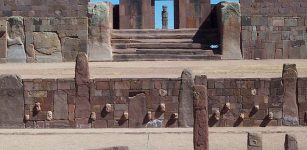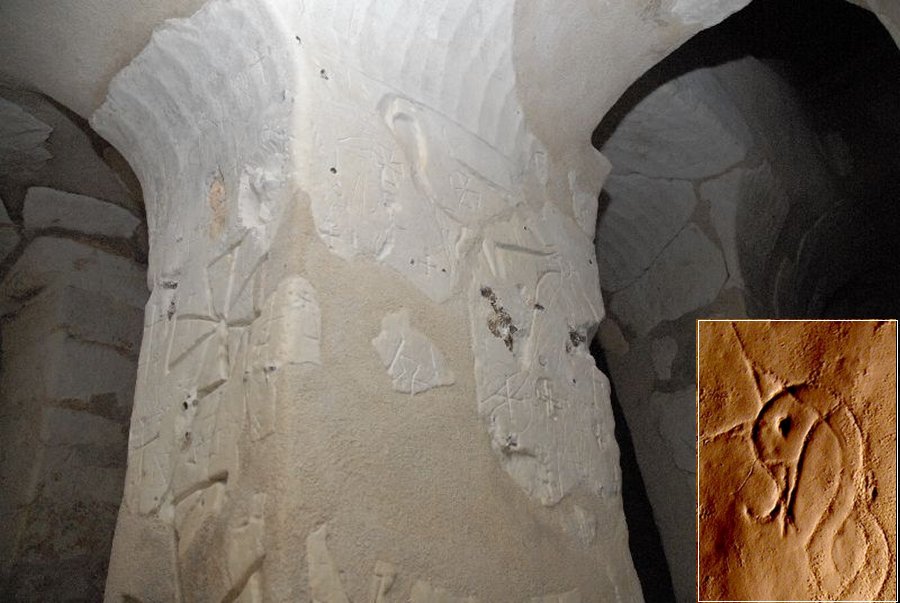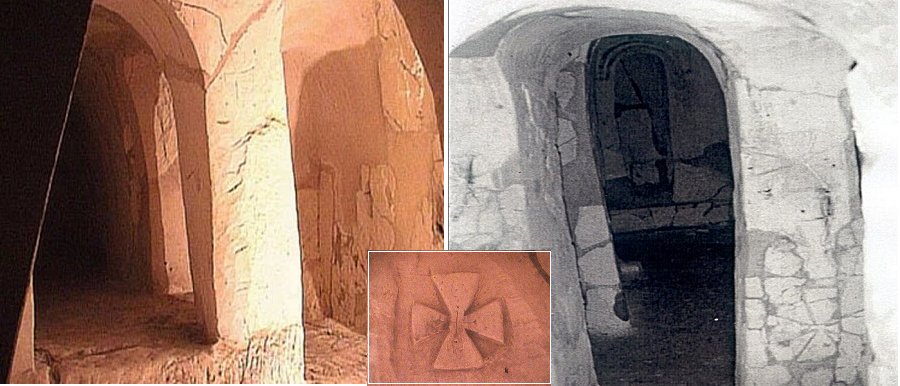Ancient Cave Church Complex In Basarabi, Romania
A. Sutherland - AncientPages.com - In 1957, a complex of caves, crypts,. six chapels, and tombs dated to 9-10th century, was found near Murfatlar, a port on the Danube-Black Sea Canal, Constanta County, Romania.
Ancient cave monastery in Basarabi was dug into the chalky limestone hill at several, different levels, into the vertical walls of the ancient quarry. Between 1924–1965 and 1980–2007, the town Murfatlar (in Turkish, "generous man") was known as Basarabi and this name is still used in respect to ancient cave complex.
Most of the chamber-walls are covered with overlapping graffiti, including drawings and multilingual inscriptions carved on the walls in Old Slavic, some in Greek alphabet and some in Turkic runes and some in Romanian. There are also runic signs, which still remain a scientific mystery.
The Basarabi culture concentrated in Southeastern Europe, mainly in Romania and dated between 8th - 7th centuries BC. It was named after Basarabi, a village in Dolj County, south-western Romania, today, an administrative part of the Calafat municipality.
This culture is related to the Hallstatt culture of the Iron Age period, the Hallstatt A (12-11th BC) and B (10-8th BC) corresponds to the late Bronze Age, Hallstatt C (7th BC) to the early Iron Age, and Hallstatt D (6th BC) to the Iron Age.
Like in some cultures of the region, the human settlements of the Basarabi culture, were usually open but sometimes also fortified, however, dwellings differed considerably within one culture.
They ranged from pit-dwellings and small huts to two-roomed rectangular houses, between 6 to 8 meters long and 3-4 meters wide.
Platforms which were frequently used in the Neolithic period, were not excavated, however, the living are of these people was equipped with a stamped clay floor.
In "Encyclopedia of Ancient Greece", Nigel Wilson writes: “the territory of modern-day Romania has been populated from the Palaeolithic period, but the country’s historical period begins in the 9th-8th centuries BC and is connected in southwestern Europe with the so-called Thracian Hallstatt period (c.600-550 BC), which corresponds to European Hallstatt C. Basarabi culture is considered the most representative of this new period within Romanian territory. The population was formed of mainly agricultural tribes living in fortified or open villages whose dwellings were constructed of timber….”
The caves of the Basarabi Church complex were discovered richly decorated with numerous drawings on the walls, depicting animals and men, riders, birds, and Christian symbols.
A large series of drawings is represented by mythical figures of monsters and dragons, along with halberds and an image of a Viking ship depicted on the walls, are all in favor of a northern origin.
During the years 1957-1962, an important monastic complex Basarabi, was discovered, near a big chalk quarry.
See also:
Mysterious Cucuteni-Trypillian Culture Burned Their Settlements For Unknown Reasons
Mysterious Underground Labyrinth With Secret Passages In Dobrogea
Spectacular Vardzia Cave Monastery – Huge Underground Complex Founded By The “Mountain Queen” Tamar
Researchers have linked these discoveries to the trade route between Scandinavian areas and Constantinople, known under the name “the route from the Varegs (= Vikings) to the Greek”.
However, they still have difficulty trying to decipher runic texts in Basarabi, due to their fragmentary preservation and the absence of many elements. It is not even known if they were written from left to right or from right to left.
For the time being, the runic writings remain undeciphered.
Written by – A. Sutherland - AncientPages.com Senior Staff Writer
Copyright © AncientPages.com All rights reserved. This material may not be published, broadcast, rewritten or redistributed in whole or part without the express written permission of AncientPages.com
Expand for referencesReferences:
Cambridge Ancient History (second addition, volume III)
More From Ancient Pages
-
 Överhogdal Tapestry: Amazingly Well-Preserved Ancient Textiles With Norse And Christian Motifs
Artifacts | Apr 26, 2019
Överhogdal Tapestry: Amazingly Well-Preserved Ancient Textiles With Norse And Christian Motifs
Artifacts | Apr 26, 2019 -
 Where Is The Grave Of Queen Boudica?
Ancient History Facts | Aug 15, 2017
Where Is The Grave Of Queen Boudica?
Ancient History Facts | Aug 15, 2017 -
 Unknown Inscription Accidentally Found In South Tower Of 13th Century Cēsis Castle In Latvia
Archaeology | Aug 18, 2020
Unknown Inscription Accidentally Found In South Tower Of 13th Century Cēsis Castle In Latvia
Archaeology | Aug 18, 2020 -
 Odeuropa – Unusual Project Will Recreate The Smells Of Old Europe And Store The Scents In A Library
News | Nov 17, 2020
Odeuropa – Unusual Project Will Recreate The Smells Of Old Europe And Store The Scents In A Library
News | Nov 17, 2020 -
 Anglo-Saxon Harpole Treasure Reveals More Secrets – Unique Medieval Silver Cross Found
Archaeology | Jan 31, 2023
Anglo-Saxon Harpole Treasure Reveals More Secrets – Unique Medieval Silver Cross Found
Archaeology | Jan 31, 2023 -
 DNA Shows First Scandinavians Followed Two Distinct Migration Routes
Archaeology | Jan 11, 2018
DNA Shows First Scandinavians Followed Two Distinct Migration Routes
Archaeology | Jan 11, 2018 -
 Ancient Kuttamuwa Stele And Iron Age Belief That Soul Lived In Funerary Slab
Featured Stories | Sep 10, 2016
Ancient Kuttamuwa Stele And Iron Age Belief That Soul Lived In Funerary Slab
Featured Stories | Sep 10, 2016 -
 Paris Of Troy: He Caused Destruction Of Troy As The Seer Had Predicted
Featured Stories | Mar 26, 2019
Paris Of Troy: He Caused Destruction Of Troy As The Seer Had Predicted
Featured Stories | Mar 26, 2019 -
 Mysterious Ancient Falicon Pyramid And Its Complex Obscure History
Featured Stories | Nov 28, 2018
Mysterious Ancient Falicon Pyramid And Its Complex Obscure History
Featured Stories | Nov 28, 2018 -
 Ancestors Of The Irish And Scots Came From Biblical Lands And Ancient Egypt – Myths, History And DNA
Civilizations | Jul 14, 2020
Ancestors Of The Irish And Scots Came From Biblical Lands And Ancient Egypt – Myths, History And DNA
Civilizations | Jul 14, 2020 -
 Superfood Of Ancient Andeans Reconstructed – What Helped To Fuel The Tiwanaku Civilization 2,500 Years?
Archaeology | Nov 30, 2021
Superfood Of Ancient Andeans Reconstructed – What Helped To Fuel The Tiwanaku Civilization 2,500 Years?
Archaeology | Nov 30, 2021 -
 Evidence Of 10,000 Years Of Violent Conflict Among The Hunter-Gatherer Societies In The Atacama Desert
Archaeology | Oct 2, 2023
Evidence Of 10,000 Years Of Violent Conflict Among The Hunter-Gatherer Societies In The Atacama Desert
Archaeology | Oct 2, 2023 -
 Necklace Of Harmony – Powerful Ill-Fated Piece Of Jewelry With Curse
Featured Stories | Jul 3, 2021
Necklace Of Harmony – Powerful Ill-Fated Piece Of Jewelry With Curse
Featured Stories | Jul 3, 2021 -
 Ancient Maya Reservoirs Can Solve Today’s Water Crises – Scientists Say
Archaeology | Oct 10, 2023
Ancient Maya Reservoirs Can Solve Today’s Water Crises – Scientists Say
Archaeology | Oct 10, 2023 -
 Royal Tombs Of Alexander The Great’s Family At Vergina, Greece Finally Identified
Archaeology | Jan 31, 2024
Royal Tombs Of Alexander The Great’s Family At Vergina, Greece Finally Identified
Archaeology | Jan 31, 2024 -
 Beads Show European Trade In African Interior Used Indigenous Routes
Archaeology | Sep 17, 2022
Beads Show European Trade In African Interior Used Indigenous Routes
Archaeology | Sep 17, 2022 -
 2,400-Year-Old Flush Toilet Discovered In China
Archaeology | Feb 24, 2023
2,400-Year-Old Flush Toilet Discovered In China
Archaeology | Feb 24, 2023 -
 Sacrificial Remains From The Iron Age Unearthed Near Aarhus, Denmark
Archaeology | Oct 14, 2015
Sacrificial Remains From The Iron Age Unearthed Near Aarhus, Denmark
Archaeology | Oct 14, 2015 -
 Ymir – Primordial Norse Giant Whose Body Parts Formed The World
Myths & Legends | Apr 5, 2018
Ymir – Primordial Norse Giant Whose Body Parts Formed The World
Myths & Legends | Apr 5, 2018 -
 When Science, Spirituality and Magic Meet – Re-Discovering Old Ancient Knowledge
Featured Stories | Feb 18, 2020
When Science, Spirituality and Magic Meet – Re-Discovering Old Ancient Knowledge
Featured Stories | Feb 18, 2020



